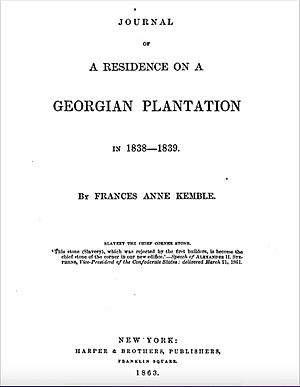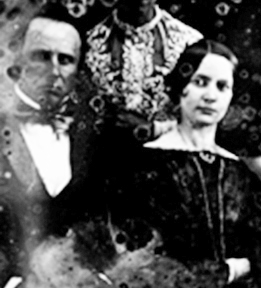Journal of a Residence on a Georgian Plantation in 1838–1839 facts for kids
Journal of a Residence on a Georgian Plantation in 1838–1839 (often called the Journal) is a famous book. It was written by Fanny Kemble, a well-known English actress. The book shares her experiences living on her husband's large farm, called a plantation, in Butler Island, Georgia.
Fanny Kemble wrote about her time there in 1838 and 1839. However, the book was not published until 1863. This was after her marriage ended and the American Civil War had started. She decided to publish it to help change opinions in England about the war and Emancipation Proclamation.
Contents
About Fanny Kemble and the Plantation
Frances Anne Kemble (1809-1893) was a famous actress from England. She met and married Pierce Mease Butler. He was from Philadelphia and owned very large rice and cotton plantations. These farms were in St. Simon's Island and Butler Island, Georgia. Hundreds of people were forced to work there as enslaved people.
While living in Philadelphia, Fanny Kemble learned about the Quakers' ideas against slavery. She began to wonder how her husband became so wealthy. He convinced her to visit the plantation with him. He thought it would help her understand and accept the plantation system.
The family traveled to the plantation in 1838. Fanny Kemble wrote in her journal about the lives of the enslaved people. She saw their living and working conditions. She became more and more against slavery, which caused problems with her husband.
Mr. Butler threatened to stop her from seeing their daughters if she wrote about her observations. The couple divorced in 1849.
What the Journal Says
The Journal shows how Fanny Kemble first felt about plantation life. At first, she liked some parts, except for "the one small thing of 'the slavery'". But she grew more and more horrified by the system.
She wrote about her talks with enslaved people. She also wrote about trying to help them by talking to her husband.
Before the Civil War, many people who were against slavery read her unpublished writings. Fanny Kemble did not want to publish her journal because of problems with her ex-husband. But when the Civil War began, England seemed to support the Southern states. So, she decided to publish her book. She hoped it would change England's views on the war and the Emancipation Proclamation.
When the Book Was Published
The Journal was first published in England in May 1863. It was published in the United States soon after. The book was out of print for a long time. Then, in 1961, Alfred A. Knopf published a new version. It included an introduction by John A. Scott.
What People Thought of It
When the Journal first came out, newspapers like New York Times and Atlantic reviewed it. The Atlantic wrote that the book was very powerful. It showed the true life inside a slave plantation. They said it helped explain why the Civil War happened. They called it a very important part of history.
In 1960, a historian named Margaret Davis Cate wrote a strong criticism of the book. She supported the plantation system. She also spoke badly about Kemble's descriptions in the Georgia Historical Quarterly.
Today, many experts say that Kemble mainly wanted better conditions for enslaved people. They note that her views against slavery came from a belief that slave owners' bad morals led to mistreatment. It was not always about the enslaved people's right to freedom.
How the Journal Made a Difference
Fanny Kemble's Journal did help change how England saw the Southern states. It also affected feelings in England about helping the South during the Civil War.
According to Encyclopedia.com, Kemble's "lasting historical importance" comes from this private journal. She kept it during her time in the Sea Islands. The University of Georgia Press says that historians have long seen it as a special book about American slavery.
The Journal also inspired a play called "Shame the Devil: An Audience with Fanny Kemble." Ann Ludlum wrote this one-woman show. It was performed in Brunswick, Georgia in 2016.



